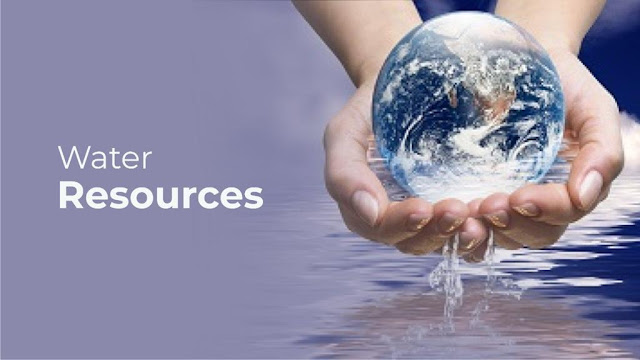Water Resources - MUIT Lucknow
Water bodies are the main driving forces of the evolution of human civilization. In ancient times, great human civilizations were established near the rivers of Nile, Indus, Tigris-Euphrates, and Yellow. The main reason for the development of human civilization near water bodies was the fulfillment of the water requirements of society, such as drinking, agriculture, and sanitation. The progress of human society entails an understanding of the hydrological nature of water bodies. In modern times, water requirements at the global level are high due to increase in population, rapid progress in urban areas, and rise of the industrial sector. Surface water and groundwater are the two water sources that satisfy the demand of the human race and the diverse ecosystems that depend on it. However, in recent times, both sources of water have been plagued by some serious problems due to large population growth, rapid industrial development, rigorous usage of chemicals, and excessive use of groundwater. Flooding and water contamination are two basic issues that affect water bodies; earlier is especially for surface water (river) and contamination of water for both sources.
Flood is one of the most common and extensively destructive natural calamities causing massive social and economic damage to various nations globally. Hydrological and topographical factors are two controlling parameters of flood. Flooding has become challenging in recent times due to rapid land-use changes, drainage blocking in low-lying regions, siltation in rivers, urban expansion in flood-prone areas, population growth, and climate change. The lack of proper flood zoning regulations and flood control response units in developing countries has increased the severity of flood problems. Categorizing the zones near a floodplain with the uppermost to the lowermost risk and the related zone-wise guidelines would be critical ideas for the preparation of upcoming developmental programs. Thus, gaining an understanding of the catchment area response to river discharge during rainfall is critically important.
During earlier periods, flood risk was primarily related to the prospect of hazard incidence. However, flood risk nowadays is also associated with the susceptibility of the system to damage. To develop a flood control system, obtaining knowledge regarding the occurrence of flood and its after effects is crucial.
The distinctive circumstances of information are vital to learning about flood occurrence (e.g., hydrological aspect means the intensity and frequency of rain, hydraulics aspect refers to the response of river to rainfall, geographical aspect pertains to flood zone, environmental aspect is the damage to the system, and civil engineering aspect denotes the response of a structure to the flood hazard). The primary aim of risk analysis is to evaluate the probable consequences related to the incidence of flooding in an area.
Flood risk management is a highly complex mechanism that comprises stakeholders who work in the fields of hydrology, hydraulics, environment, and geography, for the purposes of estimating and minimizing flood damage. The accuracy of flood damage evaluations depends on the understanding of the occurrence of flood events and the areas that are vulnerable to flood damage. Physical models are extensively used in river hydraulics, such as one-dimensional (1-D) or two-dimensional (2-D) hydrodynamic models that are based on mathematical equations describing the physical phenomena of the river flow using spatially distributed parameters.
In the past few decades, interest in the use of remote sensing (RS) and geographic information system (GIS) in hydrology and water resource management has substantially increased. Geospatial technologies provide powerful capabilities for natural hazard planning, monitoring, and mitigation. GIS is used for identifying vulnerable areas; moreover, the representation of existing terrain is possible through spatial tools and modeling techniques. The integration of spatial and non-spatial information is the core issue in the modeling activity. Flood hazard assessment, watershed management, water quality assessment, and water supply distribution are among the major water resource areas in which the modeling technique is increasingly used. In hydrological modeling, RS data are frequently used for the preparation of geometric data and a thematic map in the absence of field data.
Groundwater is a key water resource for drinking, agricultural and industrial purposes. Approximately 2.5 billion people depend only on groundwater resources to meet their domestic needs. However, the paucity of clean and potable water nowadays is evidently one of the most challenging problems in many parts of the world. In rural areas, groundwater has a crucial role in fulfilling drinking and irrigation requirements. In India, a large proportion of the population depend on agriculture, and this sector accounts for nearly 14% of the gross domestic product (GDP). People in rural areas rely on groundwater for agriculture in the absence of proper irrigation facilities such as canals. The living conditions and health risks of the rural population are governed by the groundwater quality, thereby affirming the crucial role of groundwater in rural development. About 80% of the health issues and diseases around the world are due to the consumption of contaminated water. The excessive use of groundwater has adversely affected water quality, and the lack of subsurface hydrological understanding could result in the deterioration of groundwater quality.
A water resource engineer monitors the flow of water through infrastructure systems and develops efficient water storage plans. They also work with various organizations to prevent and manage flood events. A water resource engineer uses hydrodynamics to make sure a community has sufficient resources to manage its needs. Hydrology and hydraulics are tools that make up hydrodynamics which is what a water resource engineer uses to understand fluids and how they work to accomplish a task. Many infrastructure personnel use hydrology and hydraulics together to improve and maintain environments to protect the health of both humans and ecosystems. The execution of a comprehensive study on flood vulnerability and groundwater contamination zone is therefore essential for the provision of potential solutions to the forecasted vulnerability. Both are vital to the development of guidelines for the effective protection and management of surface and groundwater.
source:




Comments
Post a Comment